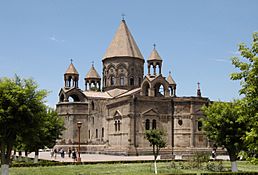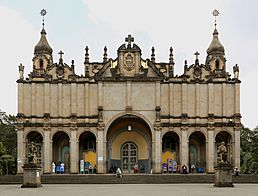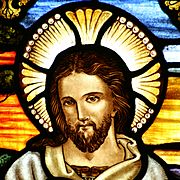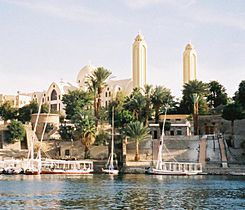Oriental Orthodox Churches facts for kids
Quick facts for kids Oriental Orthodox Churches |
|
|---|---|
|
Clockwise from top:
Etchmiadzin Armenian Apostolic Cathedral, Saint Mark's Coptic Orthodox Cathedral, Enda Mariam Eritrean Orthodox Cathedral, Holy Trinity Ethiopian Orthodox Cathedral, Malankara Orthodox Syrian Catholicate Palace, Saint George Syriac Orthodox Cathedral. |
|
| Classification | Non-Chalcedonian |
| Orientation | Eastern Christianity |
| Theology | Miaphysitism |
| Polity | Episcopal |
| Structure | Communion |
| Language | Coptic, Classical Syriac, Ge'ez, Armenian, Malayalam, Koine Greek, English, Arabic and others |
| Liturgy | Alexandrian, West Syriac and Armenian |
| Founder | Jesus Christ, according to sacred tradition |
| Separated from | Chalcedonian Christianity |
| Members | 60 million |
| Other name(s) | Oriental Orthodoxy, Miaphysite churches, Oriental Orthodox Communion |
The Oriental Orthodox Churches are a group of Eastern Christian churches. They have about 60 million members around the world. These churches are part of the Nicene Christian tradition. They are also one of its oldest branches.
As some of the oldest religious groups, Oriental Orthodox Churches have been very important. They have shaped the history and culture of places like Armenia, Egypt, Eritrea, Ethiopia, Sudan, Western Asia and India. These churches are autocephalous, meaning they are self-governing. Their bishops are all equal. Their beliefs only accept the first three major church meetings, called ecumenical councils.
There are six main self-governing Oriental Orthodox Churches. These are the Coptic Orthodox Church of Alexandria, the Syriac Orthodox Church of Antioch (which includes the Jacobite Syrian Christian Church), the Armenian Apostolic Church, the Malankara Orthodox Syrian Church, the Ethiopian Orthodox Tewahedo Church, and the Eritrean Orthodox Tewahedo Church. They believe they are the true church started by Jesus Christ. They also believe their bishops are the successors of Christ's apostles. These churches use three main worship styles: the Armenian Rite, the West Syriac Rite, and the Alexandrian Rite.
Oriental Orthodox Churches were once united with the Roman Church. This was before the Council of Chalcedon in 451 AD. They also shared beliefs with the Church of the East until 431 AD. They separated mainly because of different ideas about Christology, which is the study of Jesus Christ.
Most Oriental Orthodox Christians live in Egypt, Ethiopia, Eritrea, India, Syria, Turkey and Armenia. There are also smaller communities in Western Asia. Many have moved to other parts of the world.
Contents
What are Oriental Orthodox Churches?
The name "Oriental Orthodox Churches" was first used in 1965. This was at the Conference of Addis Ababa. At that time, five churches were part of it. The Eritrean Church became self-governing later.
Other names for these churches include Old Oriental or Miaphysite churches. The Roman Catholic Church calls them "the Ancient Churches of the East."
Beliefs and Church Structure
Oriental Orthodox Churches accept only the first three ecumenical councils. These councils happened when the State church of the Roman Empire was strong. They are the First Council of Nicaea (325 AD), the First Council of Constantinople (381 AD), and the Council of Ephesus (431 AD).
Oriental Orthodoxy shares many beliefs with the Eastern Orthodox Church. Both believe in a similar way of salvation. They also believe bishops should work together. Both honor the Theotokos (Mary, the Mother of God). They also use the Nicene Creed.
The main difference between them is how they understand Jesus Christ. Oriental Orthodoxy does not accept the Chalcedonian Definition. Instead, they follow the miaphysite idea. They believe that Jesus Christ has one nature that is both human and divine. Early leaders of these churches thought the Chalcedonian Definition might deny the Trinity. They also worried it might be too close to Nestorianism.
The separation between the Roman and Oriental Orthodox churches happened slowly. It took 2-3 centuries after the Council of Chalcedon. Eventually, they formed separate groups. Oriental Orthodox churches did not join any later ecumenical councils.
The Oriental Orthodox Churches have their own old apostolic succession. This means their leaders can be traced back to the apostles. Different churches are led by holy synods. A primus inter pares bishop leads each synod. These leaders have titles like patriarch, catholicos, and pope. The Alexandrian Patriarchate was very important in early Christian times.
Oriental Orthodoxy does not have one main leader like the Roman Catholic Church. It also does not have a leader who can call all churches together.
Some Oriental Orthodox Churches, like the Coptic Orthodox, follow Old Testament teachings more closely. Their followers may follow dietary rules like Jewish Kashrut. They also require male members to have circumcision. They observe ritual purification.
Understanding Jesus Christ
The split between Oriental Orthodoxy and other Christian groups was about how they understood Jesus. The First Council of Nicaea in 325 AD said Jesus is God. This means he is "consubstantial" with God the Father. Later, the Council of Ephesus in 431 AD said Jesus is one being or person. This is even though he is both divine and human. This council rejected Nestorianism. Nestorianism taught that Christ was two separate persons.
Twenty years after Ephesus, the Council of Chalcedon said Jesus was one person. But it also said this one person existed "in two complete natures." These were one human and one divine.
Sometimes, other Christians called Oriental Orthodox believers "monophysites." This meant they were accused of following Eutyches (around 380-456 AD). Eutyches believed Jesus was only divine, not human. Monophysitism was seen as a wrong teaching. However, Oriental Orthodox churches say this is not true. They have condemned both Nestorius and Eutyches. They call themselves miaphysite. This means they believe Christ has one nature, which is both human and divine.
Modern Connections
Today, Oriental Orthodox Churches are in full communion with each other. This means they share beliefs and sacraments. However, they are not in communion with the Eastern Orthodox Church or other churches. They do not form a single church like Catholics. Talks have started to bring the two Orthodox groups closer. There are also talks between Oriental Orthodoxy and the Catholic Church. In 2017, the Coptic Orthodox Church and the Catholic Church agreed to recognize each other's baptism. The Armenian Apostolic Church and the Catholic Church also recognize each other's baptism.
Oriental Orthodox Churches are generally seen as more traditional on social issues. They are also keen on working with other Christian Churches. All Oriental Orthodox Churches are members of the World Council of Churches.
History of Oriental Orthodoxy
After the Council of Chalcedon (451 AD)
For the leaders who became Oriental Orthodox, the Chalcedon council's words seemed to accept Nestorianism. This was a belief they disagreed with. Nestorianism saw Christ as having two separate natures, human and divine. In contrast, Cyril of Alexandria taught "One Nature of God the Incarnate Logos."
So, Oriental Orthodox Churches were often called "monophysite." But they do not like this name. It is linked to a teaching they reject. They prefer the term "miaphysite."
After Chalcedon, the leaders in Constantinople sometimes stayed in touch with the non-Chalcedonian leaders. These were from Alexandria and Antioch. Rome, however, was not in communion with Alexandria and Antioch. Rome also had unstable ties with Constantinople. It was not until 518 AD that Emperor Justin I demanded that the Roman Empire's church accept Chalcedon's decisions.
20th Century Developments
By the 20th century, the split from Chalcedon was not seen as important. Leaders from the Holy See (Catholic Church) and Oriental Orthodoxy met several times. They made statements to bring their churches closer. For example, in 1984, Syriac Patriarch Mar Ignatius Zakka I Iwas and Roman Pope John Paul II said:
The confusions and schisms that occurred between their Churches in the later centuries, they realize today, in no way affect or touch the substance of their faith, since these arose only because of differences in terminology and culture and in the various formulae adopted by different theological schools to express the same matter. Accordingly, we find today no real basis for the sad divisions and schisms that subsequently arose between us concerning the doctrine of Incarnation. In words and life we confess the true doctrine concerning Christ our Lord, notwithstanding the differences in interpretation of such a doctrine which arose at the time of the Council of Chalcedon.
This means they agreed that their past differences were mostly about words and culture. They felt there was no real reason for the split over the teaching of Jesus Christ.
Worship Practices
Oriental Orthodox Christians, like Copts, Syrians, and Indians, use prayer books. These are called the Agpeya and Shehimo. They pray seven times a day. They face eastward towards Jerusalem. This is because they expect the Second Coming of Jesus. This practice comes from Psalm 119:164. There, King David prays to God seven times a day.
Before praying, they wash their hands and face. This is to be clean before God. They also take off their shoes. This shows respect for a holy God. In this Christian tradition, women usually wear a Christian headcovering when they pray.
How Oriental Orthodox Churches are Organized
The Oriental Orthodox Churches are a group of six self-governing regional churches. This means each church manages itself.
Here is a list of the six main Oriental Orthodox churches:
- Alexandrian Rite
- Coptic Orthodox Church of Alexandria
- French Coptic Orthodox Church
- Ethiopian Orthodox Tewahedo Church
- Eritrean Orthodox Tewahedo Church
- Coptic Orthodox Church of Alexandria
- Syro-Antiochene Rite
- Syriac Orthodox Church of Antioch
- Jacobite Syrian Christian Church
- Malankara Orthodox Syrian Church
- Syriac Orthodox Church of Antioch
- Armenian Rite
- Armenian Apostolic Church
- Mother See of Holy Etchmiadzin
- Armenian Patriarchate of Constantinople
- Armenian Patriarchate of Jerusalem
- Holy See of Cilicia
- Mother See of Holy Etchmiadzin
- Armenian Apostolic Church
There are also some churches that are not officially recognized. But their members may still be in communion with the larger Oriental Orthodox group. Examples include the Celtic Orthodox Church. The leaders of these churches are sometimes called episcopi vagantes.
Where Members Live
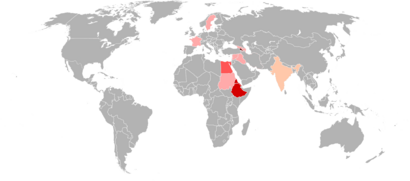
According to the Encyclopedia of Religion, Oriental Orthodoxy is very important in the Middle East. It has the most followers there. These churches have been in the Middle East since before Islam spread.
It is the main religion in Armenia (94%). It is also dominant in the ethnically Armenian Nagorno-Karabakh Republic (95%).
Oriental Orthodoxy is a major religion in Ethiopia (43.1%). It is most common in the Amhara (82%) and Tigray (96%) regions. It is also strong in the capital city of Addis Ababa (75%). It is one of two main religions in Eritrea (40%).
It is a smaller group in Egypt (less than 20%). It is also a minority in Syria (2–3% of Christians). In Lebanon, it makes up about 10% of Christians. In Kerala, India, it is 7% of Christians. The Ethiopian Church is the largest Oriental Orthodox church. It is the second largest Orthodox church overall, after the Russian Orthodox Church.
The Armenian Patriarchate of Constantinople in Turkey is also important. So is the Armenian Apostolic Church of Iran. These churches are the largest Christian minority in these mostly Muslim countries.
Disagreements Within the Churches
There are some ongoing disagreements within the Oriental Orthodox Churches. These can sometimes affect how well they work together.
Armenian Apostolic Church Issues
The least serious disagreement is within the Armenian Apostolic Church. It is between the Catholicosate of Etchmiadzin and the Catholicosate of the Great House of Cilicia.
This split became stronger during the Soviet era. Some Western bishops thought the Etchmiadzin See was controlled by the Communists. So, they started churches that were independent of Etchmiadzin. They instead showed loyalty to the See in Antelias, Lebanon. The split became official in 1956.
Ethiopian Church Issues
In 1992, Abune Merkorios stepped down. Abune Paulos was then elected. Some Ethiopian Orthodox bishops in the United States said the new election was not valid. They declared their independence from the Addis Ababa church. They formed a separate synod. On July 27, 2018, both groups reached an agreement. Abune Merkorios was brought back as Patriarch. Abune Mathias (who followed Abune Paulos) still handles daily duties. The two synods joined back together. Any past excommunications were lifted.
Indian Church Issues
Indians who follow the Oriental Orthodox faith belong to two churches. These are the Malankara Orthodox Syrian Church and the Jacobite Syrian Christian Church. These two churches were united before 1912 and after 1958. But they separated again in 1975. The Malankara Orthodox Syrian Church is self-governing. It is led by the Catholicos of the East and Malankara Metropolitan. The Jacobite Syrian Christian Church is part of the Syriac Orthodox Church in India. It is led by the regional head Catholicos of India.
The Malabar Independent Syrian Church also follows Oriental Orthodox traditions. But it is not in communion with other Oriental Orthodox churches.
Common Misunderstandings
The Assyrian Church of the East is sometimes wrongly called an Oriental Orthodox church. But its origins are from disputes that happened before the Council of Chalcedon. It also has a different understanding of Jesus. The historical Church of the East was in Greater Iran. It declared itself separate from the state church of the Roman Empire in 424–27 AD. This was years before the Councils of Ephesus and Chalcedon. Theologically, the Church of the East was linked to Nestorianism. It rejected the Council of Ephesus, which said Nestorianism was wrong. The Oriental Orthodox Churches' understanding of Jesus actually developed against Nestorianism. Nestorianism stresses the separate human and divine natures of Christ.
See also
 In Spanish: Iglesias ortodoxas orientales para niños
In Spanish: Iglesias ortodoxas orientales para niños
- Interparliamentary Assembly on Orthodoxy
- List of Christian denominations
- Oriental Orthodoxy in North America
Images for kids


